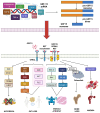The Multifaceted Role of Growth Differentiation Factor 15 (GDF15): A Narrative Review from Cancer Cachexia to Target Therapy
- PMID: 40868185
- PMCID: PMC12383714
- DOI: 10.3390/biomedicines13081931
The Multifaceted Role of Growth Differentiation Factor 15 (GDF15): A Narrative Review from Cancer Cachexia to Target Therapy
Abstract
Background: Growth Differentiation Factor 15 (GDF15) has emerged as a key biomarker and therapeutic target in oncology, with roles extending beyond cancer cachexia. Elevated GDF15 levels correlate with poor prognosis across several solid tumors, including colorectal, gastric, pancreatic, breast, lung, prostate, and head and neck cancers. GDF15 modulates tumor progression through PI3K/AKT, MAPK/ERK, and SMAD2/3 signaling, thereby promoting epithelial-to-mesenchymal transition, metastasis, immune evasion, and chemoresistance via Nrf2 stabilization and oxidative stress regulation. Methods: We performed a narrative review of the literature focusing on the role of GDF15 in solid tumors, with a particular emphasis on head and neck cancers. Results: In head and neck squamous cell carcinoma (HNSCC), GDF15 overexpression is linked to aggressive phenotypes, radioresistance, poor response to induction chemotherapy, and failure of immune checkpoint inhibitors (ICIs). Similar associations are observed in colorectal, pancreatic, and prostate cancer, where GDF15 contributes to metastasis and therapy resistance. Targeting the GDF15-GFRAL axis appears therapeutically promising: the monoclonal antibody ponsegromab improved cachexia-related outcomes in the PROACC-1 trial, while visugromab combined with nivolumab enhanced immune response in ICI-refractory tumors. Conclusions: Further investigation is warranted to delineate the role of GDF15 across malignancies, refine patient selection, and evaluate combinatorial approaches with existing treatments.
Keywords: GDF15; GFRAL; cachexia; cancer biomarker; chemotherapy resistance; head and neck cancer.
Conflict of interest statement
The authors declare no conflict of interest.
Figures


References
-
- Associazione Italiana di Oncologia Medica (AIOM) Linee Guida AIOM per il Trattamento e la Prevenzione Della Cachessia Neoplastica. 2024. [(accessed on 24 May 2025)]. Available online: https://www.aiom.it/linee-guida-aiom-2024-trattamento-e-prevenzione-dell...
-
- Caillet P., Liuu E., Raynaud Simon A., Bonnefoy M., Guerin O., Berrut G., Lesourd B., Jeandel C., Ferry M., Rolland Y., et al. Association between cachexia, chemotherapy and outcomes in older cancer patients: A systematic review. Clin. Nutr. 2017;36:1473–1482. doi: 10.1016/j.clnu.2016.12.003. - DOI - PubMed
Publication types
LinkOut - more resources
Full Text Sources
Miscellaneous

